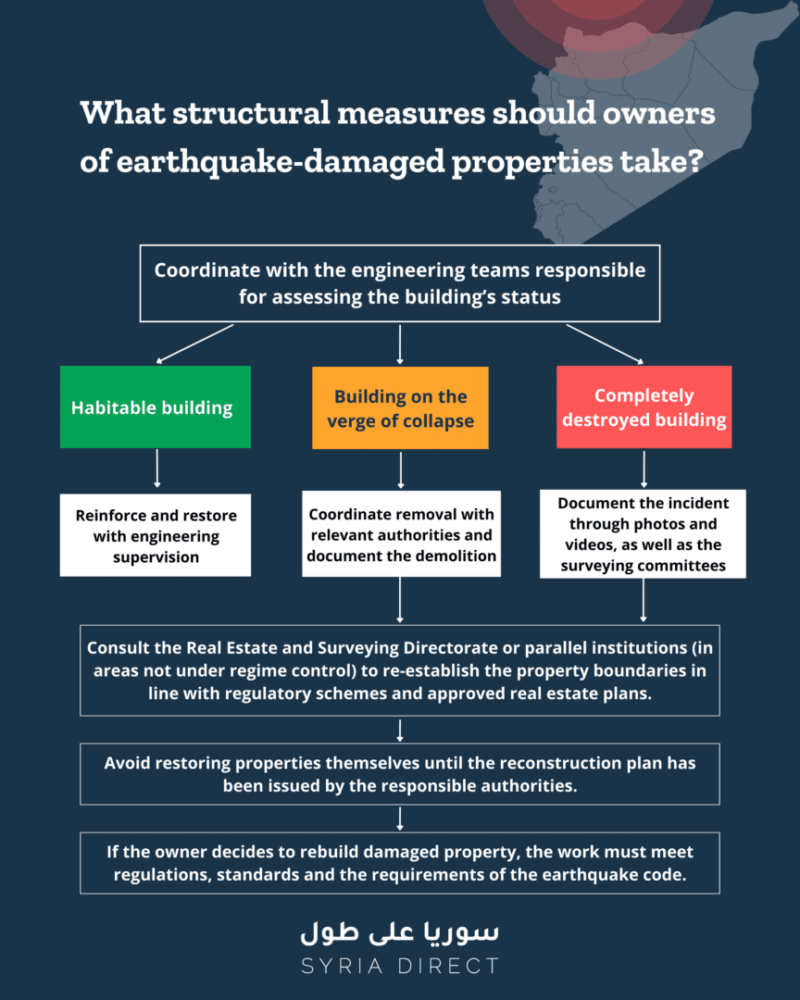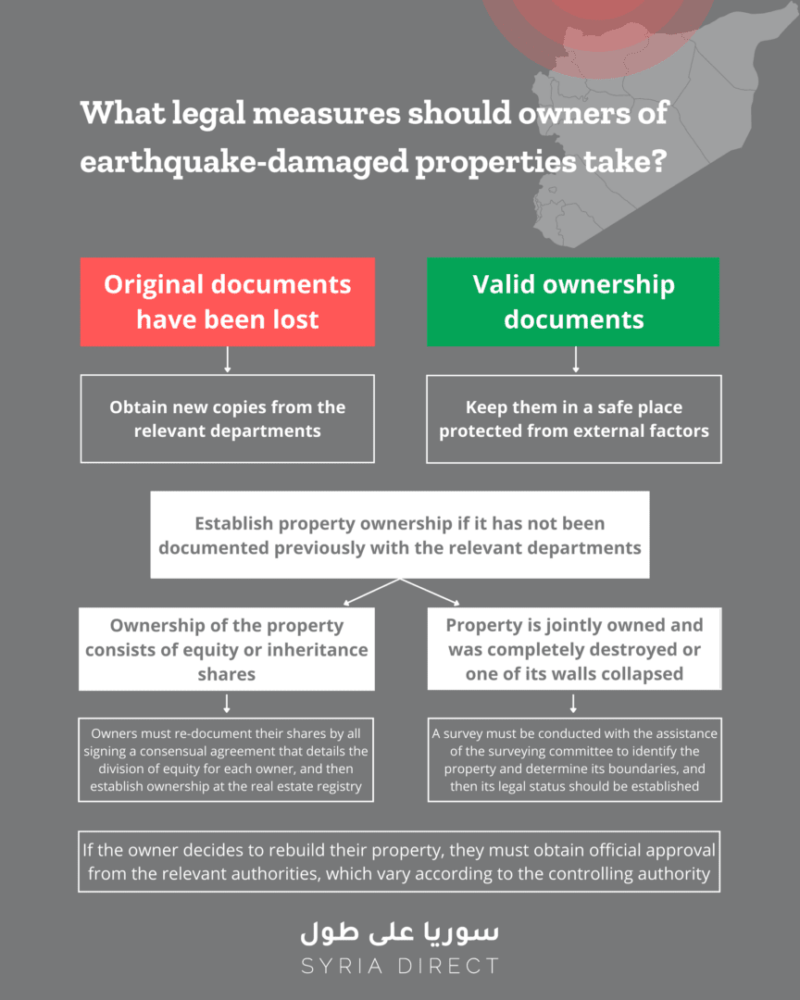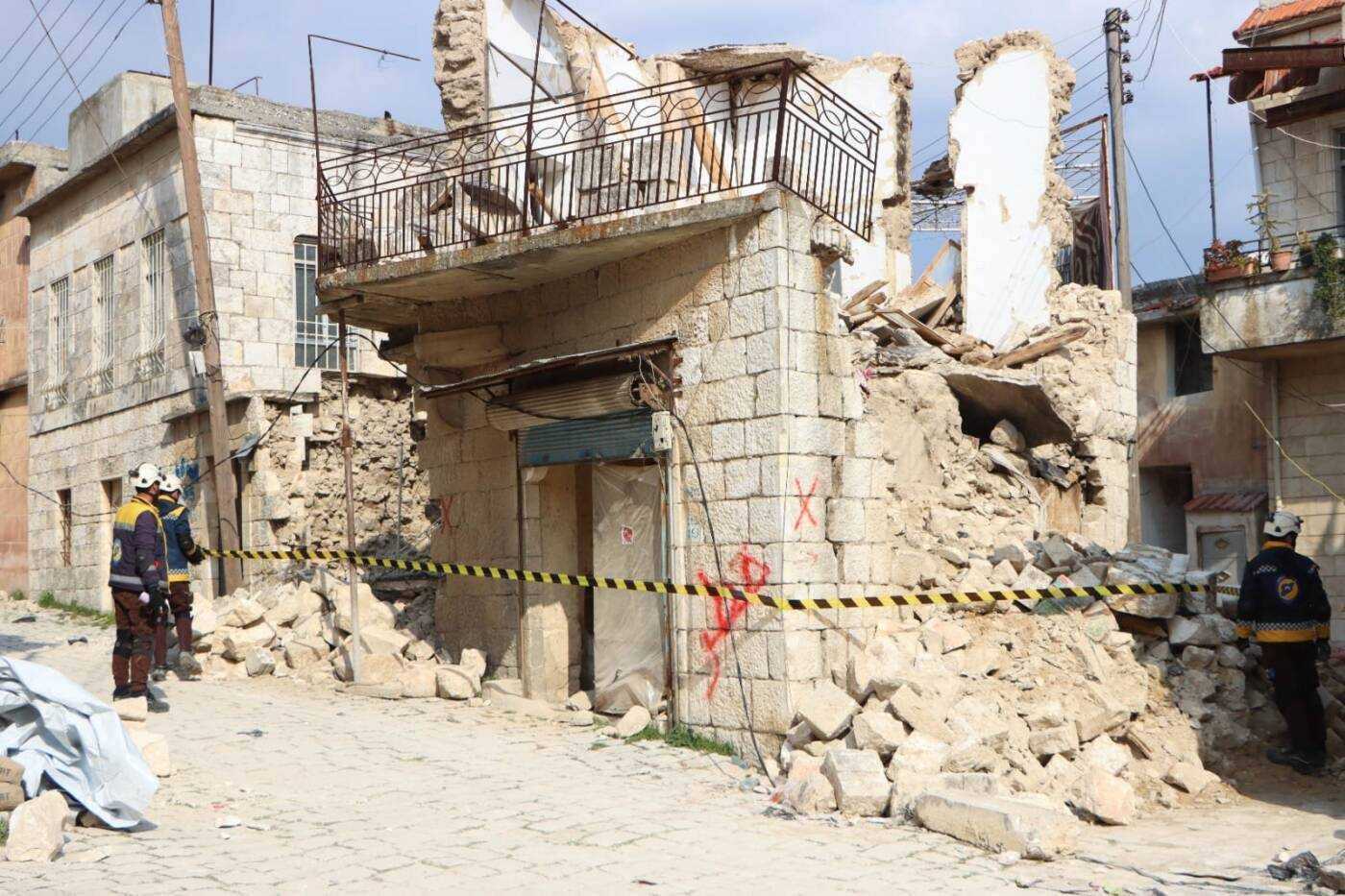Does the earthquake threaten real estate ownership in Syria? How can it be protected?
Extensive earthquake damage to residential buildings in Syria raises many questions about what structural and legal measures those affected should take to protect their property.
3 March 2023
PARIS — Thousands of buildings in Syria were completely or partially damaged by the devastating earthquake that struck Turkey and Syria on February 6, claiming the lives of 48,000 people.
In parts of the northern Aleppo countryside controlled by the opposition Syrian Interim Government (SIG), 2,500 buildings were completely or partially damaged by the 7.7-magnitude earthquake, while 6,709 were damaged in areas of Idlib controlled by the Salvation Government, the civilian front of Hay’at Tahrir al-Sham (HTS). Hundreds more were damaged in Damascus-controlled areas, including 350 in Latakia province.
Given the extent of the damage, especially in northwestern Syria, which has seen an increase in informal construction in recent years, questions arise about what structural and legal measures those affected by earthquake damage should take to protect and preserve their property.
What structural measures should I take?
The first step owners of residential buildings should take to preserve their real estate is to “coordinate with the engineering teams formed by local councils, construction directorates and engineering associations that are assessing the state of homes and analyzing the earthquake’s impact in terms of cracks and fissures,” structural engineer Muhanad al-Jahmani told Syria Direct from his home in the northern Aleppo countryside city of al-Bab.

Infographic: What structural measures should owners of earthquake-damaged properties take? (Syria Direct) – For full resolution click here.
Furthermore, “the building [should be] reinforced with engineering supervision if it is habitable, and cracks should be repaired, with constant monitoring of the building,” al-Jahmani said. If a building is on the verge of collapse and there is no point in reinforcing it, “it should be removed by the relevant authorities operating in that area, and the demolition should be documented. This is to avoid any additional damage to neighboring buildings if the process were to be carried out by non-specialists,” he explained.
In the event a building has completely collapsed due to the earthquake, the owner should “document the incident using photos and videos as well as through the relevant surveying committees assessing the earthquake’s impact,” al-Jahmani said. It would be best for “people affected to wait for a plan from the authorities responsible for reconstruction before proceeding with construction,” he added.
In opposition-controlled areas of northwestern Syria, it appears that, for now, “the responsible authorities have no plans, or are unable, to rebuild,” so “real estate owners can arrange for rubble to be removed by specialized companies that buy rubble to grind it down for reuse in the quarrying industry, and recycle the reinforcing steel found in the rubble for non-structural use,” al-Jahmani explained.
In SIG areas, it is important to refer to the Real Estate and Surveying Directorate or the parallel institutions in order to “reconfirm the property boundaries in line with approved regulatory and real estate plans.” If property owners decide to rebuild themselves, “the construction must meet regulations, standards and the requirements of the earthquake code,” al-Jahmani said.
In Idlib, the Salvation Government has laid out specific procedures for restoring and reconstructing buildings damaged by the earthquake, Abdul Baset Qirata, head of the de facto government’s General Directorate for Real Estate Issues, told Syria Direct.
Real estate owners who wish to restore or build properties must “obtain a license from the Technical Services Directorate within the Salvation Government,” and this process requires “a survey plan, a real estate registration statement and title deeds.” If these have been lost as a result of the earthquake, “the General Directorate for Real Estate Issues shall, at the request of the relevant person, provide the required real estate documents, in addition to redetermining and clarifying the borders and boundaries of properties damaged by the earthquake,” Abdul Baset said.
Preserving real estate rights
More than three weeks after the disaster, no legal procedure has been developed for dealing with real estate damaged by the earthquake in Syria. However, anyone who has lost documents pertaining to their real estate must “obtain replacements for them,” Muhammad Haj Abdo, a lawyer who heads the Afrin City Council’s Legal Office, told Syria Direct.
People who own real estate that was partially or completely destroyed by the earthquake should take a number of measures, including “confirming property ownership” if it was not previously documented with relevant departments, a lawyer in the Afrin countryside said.

Infographic: What legal measures should owners of earthquake-damaged properties take (Syria Direct) – For full resolution click here.
Since most real estate properties in opposition-controlled areas “are jointly owned,” the owners of damaged buildings need to “conduct an assessment through the surveying committee to identify the property and determine its borders. They must then establish their ownership of the property,” the lawyer explained to Syria Direct. He asked not to be identified for safety reasons.
The lawyer added that those who “own an equity or inheritance share in a jointly owned building that has been completely damaged, or who own apartments in buildings where ownership is not subdivided by floor,”are at a greater risk of losing their rights.
For this reason, determining the “characteristics, area and boundaries of the apartments” through the surveying committee,” and then establishing property ownership, is necessary to “avoid a property owner clearing the site of the collapsed building and depriving the others of their rights.”
This also applies to damaged buildings in regime-controlled areas, as “owners of properties with confirmed ownership or partial ownership, whether partially or completely damaged, need not be worried,” the lawyer said. Rather, “the biggest concern relates to areas of informal and unregistered housing, or buildings for which ownership has not been established outside of sales contracts.”
The lawyer was concerned about “the demolition or confiscation of homes whose ownership has not been established” in Damascus-controlled areas, or the application of “previously issued legislation, such as Law 10, relating to the regulation of informal neighborhoods.”
There are also fears surrounding “the establishment of new development zones in the areas affected by the earthquake, the eviction of remaining residents in these affected areas and the handing over of these areas to companies linked to the regime under the pretext of reconstruction, especially as many of the residents of these areas are outside the area or are wanted [by the authorities] and any request requires security approvals,” he said.
He is also concerned “the regime [could] claim that areas that were damaged or destroyed by its own forces’ bombardment are earthquake-affected areas, and thereby shield itself from any later international accountability related to international conventions and treaties for its bombardment of civilian targets.”
Real estate crisis
In theory, a property owner can obtain ownership documents to replace lost or damaged documents—whether a title deed (green tabu), court ruling, or power of attorney—by going to the real estate registration office, court or party that issued the original to obtain a new certified copy.
But, as in the case of residents of opposition-controlled areas whose documents were issued by regime offices, property owners may be unable to reach the institution that issued the document. For this reason, it is best to “keep property documents nearby in a safe place, protected from external factors and the elements, so that they are easily accessible in the event of displacement or natural disasters. Digital copies of these documents should also be kept in any way possible so that they can be referred to as and when needed,” the lawyer in Afrin said.
The legal status of most real estate in northwestern Syria is “ownership through shares in common or possession,” because “the ownership is not subdivided,” the lawyer explained. The legal status of the property remains the same as before the earthquake, and “there is no problem if the building is a detached house.”
Ownership also does not change for damaged buildings that were built on common land, or for jointly owned properties. However, in such cases, it is necessary to “re-document ownership, for all owners to sign a new consensual agreement detailing the division of equity for each owner, then confirm ownership through the real estate registry by filing an independent claim or rearranging the division of the property,” the lawyer said. Reconstruction should then be done “in line with the equity and agreement of the owners.”
In SIG-controlled areas of the northern Aleppo countryside, “ for buildings that collapsed following the earthquake and were built on common, endowment (waqf), state-owned or reclaimed land, or any other land for which the owner has no title deed, the owner of the building must coordinate with the local council or the committee responsible for managing the land to document the incident and rebuild,” al-Jahmani, from the Afrin Local Council, said.
As for buildings on endowment or public land in the areas controlled by the HTS-backed Salvation Government, “if there is a technical survey of the building, the General Directorate for Real Estate Issues may, through the Surveying Directorate, redetermine the boundaries in line with where they were previously built,” Qirata said.“A request to establish ownership of such buildings requires the person concerned to consult the owning party, such as the Ministry of Religious Endowments or the Directorate of State Property.”
Complicating the process of determining property boundaries, “many minarets were destroyed by the earthquake, which the General Directorate used the tops of as reference points,” Qirata said. As a result, “a new reference point system needs to be developed.”
This report was originally published in Arabic.







